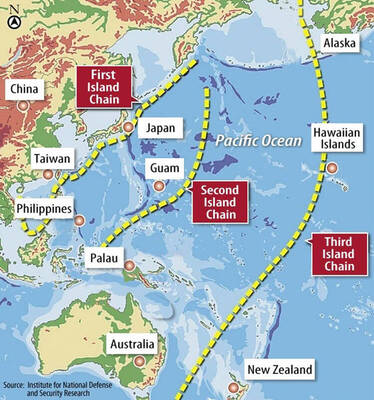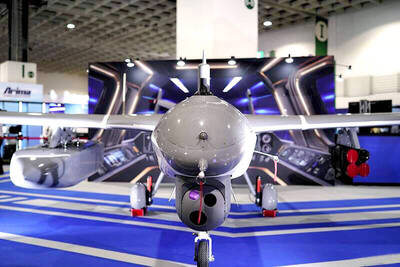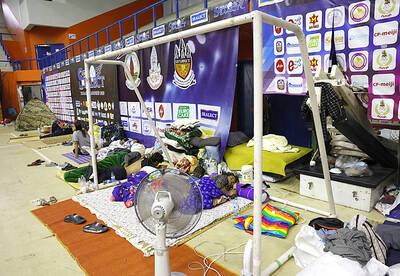A US congressional report released this week makes it clear that, without the acquisition of new aircraft, the Taiwanese air force risks being a shadow of itself by 2020 and incapable of meeting the challenge it faces in the Taiwan Strait.
The annual report by the Congressional Research Service, entitled Taiwan: Major US Arms Sales Since 1990 — which Defense News has called “required reading inside Taiwan defense circles and among US defense officials working with the island’s military” — provides a detailed analysis of US arms sales to Taiwan over more than two decades.
The section on F-16 jet sales provides the greatest shock. By 2020, it says, the number of fighter aircraft in the air force would drop by 70 percent without the acquisition of new F-16s as it retires near-obsolete F-5s and some ageing Mirage 2000s, whose spare parts are reportedly extremely costly.
Even if Taiwan were to acquire the 66 F-16C/Ds it has been requesting since 2006, the total number of aircraft would still have dropped by 50 percent by that time, the report says.
In numerous requests to the US over the years, Taiwan had made it clear that it understands the severity of the shortage it faces within the next decade and it has argued that it is seeking both upgrades for its 145 F-16A/Bs sold in 1992 and new aircraft.
In a letter of request submitted in November 2009, Taiwan wrote that the upgrade program would by necessity be “in parallel to, and not a substitute for, new F-16C/D” aircraft.
On a visit to the US in September last year, Vice Minister of National Defense Andrew Yang (楊念祖) called the F-16C/Ds and diesel-electric submarines — another program that has been stalled for several years — the most urgent systems for Taiwan to acquire, not the F-16A/B upgrades.
A notification to Congress in September last year included a US$5.2 billion upgrade package for the F-16A/Bs, but not the new F-16C/Ds. The Ministry of National Defense says the retrofits, which would be budgeted over a period of 12 years, would bring the F-16A/Bs’ capabilities to 80 percent of those of the F-16C/D, with some capabilities even surpassing the F-16C/D.
However, the package does not include new engines, meaning that their operational range would remain more limited than that of F-16C/Ds. The program also does not include airframe work, leaving unaddressed the problem of ageing aircraft that have now been in service for two decades.
According to Lockheed Martin, a retrofit would not start until 2017, after five years of preparatory work. Once it begins, it would take one squadron, or about 24 F-16A/Bs, out of service at a time over a period of five years.
Furthermore, the program would take three years longer than a program to sell the same number of 145 new F-16C/D fighters, which it says would take seven years.
During that same period, a number of Indigenous Defense Fighters (IDF) will also be out of service for mid-life upgrades, further compounding the quantitative crisis.
More recent events, which are not covered in the CRS report, seem to indicate that Taiwan is having second thoughts about running the two programs in parallel. Earlier this month, legislators and senior military officials said that the F-16A/B upgrades were more expensive than expected and that Taiwan might not have the financial resources to do both. Some also argued that rather than purchase the new F-16C/Ds, Taiwan should instead bid for Lockheed Martin’s F-35B, a problem-plagued aircraft that is still under development.
Such signaling has given rise to speculation in defense circles that Taiwan might want out of the F-16C/D project, at a time when the White House may finally be willing to make the aircraft available. A defense industry source told the Taipei Times yesterday that Taiwan’s National Security Council has been informed of the urgency of submitting a new letter of request for the F-16C/Ds to push the issue, but that such recommendations had “disappeared into a black hole.”
A strong indicator of a possible shift occurred on Thursday when President Ma Ying-jeou (馬英九) met former Florida governor Jeb Bush, who arrived the same day on a three-day visit.
Although some were expecting that Ma would restate Taiwan’s interest in acquiring the F-16C/Ds, the president only mentioned the upgrades, telling Bush he hoped the program would provide the F-16A/Bs with capabilities “close to” those of the F-16C/Ds.

The US government has signed defense cooperation agreements with Japan and the Philippines to boost the deterrence capabilities of countries in the first island chain, a report by the National Security Bureau (NSB) showed. The main countries on the first island chain include the two nations and Taiwan. The bureau is to present the report at a meeting of the legislature’s Foreign Affairs and National Defense Committee tomorrow. The US military has deployed Typhon missile systems to Japan’s Yamaguchi Prefecture and Zambales province in the Philippines during their joint military exercises. It has also installed NMESIS anti-ship systems in Japan’s Okinawa

‘WIN-WIN’: The Philippines, and central and eastern European countries are important potential drone cooperation partners, Minister of Foreign Affairs Lin Chia-lung said Minister of Foreign Affairs Lin Chia-lung (林佳龍) in an interview published yesterday confirmed that there are joint ventures between Taiwan and Poland in the drone industry. Lin made the remark in an exclusive interview with the Chinese-language Liberty Times (the Taipei Times’ sister paper). The government-backed Taiwan Excellence Drone International Business Opportunities Alliance and the Polish Chamber of Unmanned Systems on Wednesday last week signed a memorandum of understanding in Poland to develop a “non-China” supply chain for drones and work together on key technologies. Asked if Taiwan prioritized Poland among central and eastern European countries in drone collaboration, Lin

Renewed border fighting between Thailand and Cambodia showed no signs of abating yesterday, leaving hundreds of thousands of displaced people in both countries living in strained conditions as more flooded into temporary shelters. Reporters on the Thai side of the border heard sounds of outgoing, indirect fire yesterday. About 400,000 people have been evacuated from affected areas in Thailand and about 700 schools closed while fighting was ongoing in four border provinces, said Thai Rear Admiral Surasant Kongsiri, a spokesman for the military. Cambodia evacuated more than 127,000 villagers and closed hundreds of schools, the Thai Ministry of Defense said. Thailand’s military announced that

CABINET APPROVAL: People seeking assisted reproduction must be assessed to determine whether they would be adequate parents, the planned changes say Proposed amendments to the Assisted Reproduction Act (人工生殖法) advanced yesterday by the Executive Yuan would grant married lesbian couples and single women access to legal assisted reproductive services. The proposed revisions are “based on the fundamental principle of respecting women’s reproductive autonomy,” Cabinet spokesperson Michelle Lee (李慧芝) quoted Vice Premier Cheng Li-chiun (鄭麗君), who presided over a Cabinet meeting earlier yesterday, as saying at the briefing. The draft amendment would be submitted to the legislature for review. The Ministry of Health and Welfare, which proposed the amendments, said that experts on children’s rights, gender equality, law and medicine attended cross-disciplinary meetings, adding that